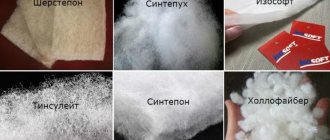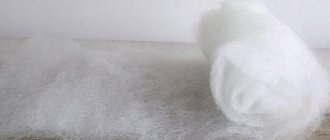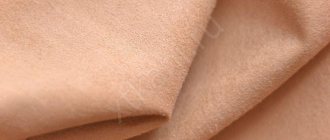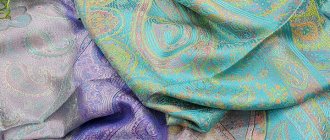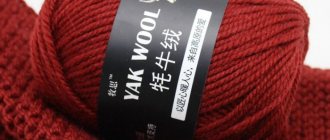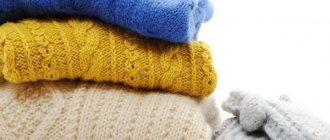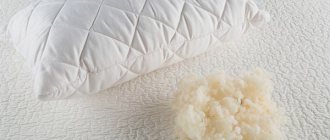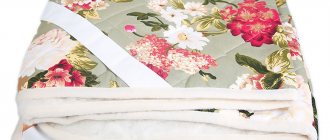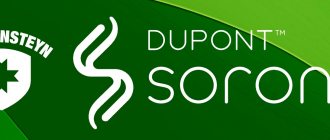Home / Fillers
Back
Published: 06/29/2021
Reading time: 2 min
0
7
The wide selection of insulation materials on the markets can make you feel confused. Not long ago, a new species appeared on the shelves - woolcrown. Sherstipon is a new generation non-woven material, it is made from polyester fibers and animal hair. Thanks to this combination in the composition, the insulation acquires a great advantage over others and is actively used in the light textile industry.
- 1 Manufacturing and possible composition
- 2 Quality characteristics 2.1 Pros
- 2.2 Cons
What kind of material
Sherstipon is a Russian-made insulation material. It is an improved type of padding polyester. The filler can also be found on sale under the names: shersikon, shervisin, shersikron.
The new generation of insulation is warmer than its predecessor, padding polyester. It is superior in heat-preserving functions to holofire. While woolpon is not inferior to Thinsulate in its warming qualities, it is inferior in water-repellent properties.
The material compares favorably with elasticity and plasticity from batting. It is also more durable and not subject to deformation.
On average, a product with wool-pon filler lasts at least 6–7 years. With Thinsulate – up to 10 years, and with classic synthetic padding – about 3 years.
Properties of sherstepone
This name combines a large group of materials with different contents of wool and polyester fibers. The density of insulation varies widely: from 60 g/m² to 300 g/m². Some types of shervisin have a density of 600 g/m². The entire group of sherstepons is characterized by basic common properties.
- The insulation has high hygienic qualities. Natural and synthetic raw materials are thoroughly washed to remove foreign impurities.
- The increased hygroscopicity of sherstepon is explained by the presence of wool fibers. Clothing with such insulation is capable of absorbing vapors from the physiological moisture of the skin.
- High heat-retaining qualities are due to the properties of wool and hollow polyester fibers.
- Light, elastic, plastic material takes on the contours of the body and does not create problems with human movements.
- Woolstepon does not pill and holds its shape well. If the designer wishes, material with moderate density can be easily draped.
- Manufacturers talk about the low allergenicity of the material. They explain this by thoroughly cleaning the wool. If the technology is strictly followed, the allergenicity of wool is probably reduced. However, in our opinion, people with hypersensitivity to wool should check their reaction to Sherstepon before purchasing. Try to place the product on your hand, lightly rub it against the skin, and hold for a few minutes. The next day, inspect the contact area. In the absence of external irritations, we can conclude that the material is well tolerated.
- Sherstepon is durable. Both components, having passed the stage of thermal bonding, withstand long-term use of products, washing, and cleaning. Some users talk about deformation of sherstepon after washing. Apparently, the item was made by folk craftsmen in semi-handicraft conditions. Carefully check the availability of quality certificates for products. Qualified manufacturers produce durable products.
Composition and properties
The composition of woolpon includes natural sheep or camel, less often goat wool and hollow polyester fibers. The percentage varies depending on the manufacturer's specifications. The regulated amount of wool is at least 50%. Most often this figure is in the range of 60 – 70%.
The material is produced using one of two technologies: needle-punched or thermal bonding. Depending on the purpose, the insulation can be of different densities (100 g/m2, 150 g/m2, 200 g/m2, 300 g/m2, 600 g/m2).
So I use 200 g/m2 woolpon for sewing outerwear, and for blankets – 100 – 150 g/m2. To insulate jackets and coats, woolpontons with lining are produced, and quilted ones are more often used for the production of bedspreads and blankets.
Casual outerwear with wool wool is designed for frost down to minus 30°C. Manufacturers of sports equipment and outdoor clothing use denser wool wool (from 300 to 600 g/m2). The equipment is capable of heating at air temperatures down to minus 40°C.
Provided that the wool has gone through all stages of cleaning and processing, the color of the woolpona is white or beige.
What and how is sherstepon made from?
The material is produced by many domestic manufacturers. It is found under the names:
- woolpon;
- sherstepon;
- woolcrown;
- shervisin;
- wool;
- is part of the ultrastep.
Coat with charstipone filling
All manufacturers claim a combination of wool and polyester fibers in the insulation. The synthetic fibers that make up sherstepon are thin hollow tubes twisted into a spiral. The degree of twist may vary.
With wool the situation is somewhat different. Some manufacturers introduce sheep wool into the composition, others claim the content of camel wool in the composition of sherstepon. The ratio of polyester and wool fibers may vary. In some products the wool content is only 20%, in others it reaches 80%.
Most products have intermediate levels of wool content in the material. The ratio of natural and polyester fibers can be changed according to the customer’s request. The content of the initial components significantly affects the density, thickness, and properties of insulation.
The sherstepon manufacturing technology allows the use of substandard wool. Almost all manufacturers card the fibers to form webs. Then the fibrous raw material is subjected to thermal bonding, during which the polymer part softens slightly and sticks where it touches each other. The heated polyester fibers are additionally combined with wool.
Wool filler
Some manufacturers, for example, in addition to thermally bonded fabrics, produce needle-punched (canvas-stitched material) on a sandbond frame base. This company alone produces 8 types of sherstepon.
produces shervisin and sherstepon simultaneously. Specific data on the fiber content of each type of product is not presented on the official website. Shervisin with a density of 150 g/m² is recommended for filling blankets. Sherstepon with the same density is recommended for insulating jackets and bedding.
According to some sources, shervisin may contain goat hair. Perhaps this factor made it possible to identify a separate group with a different name. Considering that all manufacturers file patents for technologies, finding the truth can be difficult.
Application area
Sherstipon is used in the production of outerwear (coats, down jackets, fur coats). It is also used to make home textiles and sports equipment.
The material is used to insulate women's, men's, and children's clothing. It is used as a quilted lining for winter coats or jackets.
The filler has proven itself well in suits for active winter recreation. They also fill sleeping bags with it.
Insulation for clothing is used for the production of hats. Most often these are hats for children.
Woolstipone is used as a filler for mattresses. But blankets with this filling have become more widespread. It is also used for stuffing pillows or sewing voluminous, quilted bedspreads. Thanks to the ecological purity of raw materials, children's blankets are produced from woolpon.
Qualitative characteristics
The material is used as a filler for outerwear and blankets. Due to its unique composition, it has both advantages and disadvantages.
pros
- Environmentally friendly product;
- Non-allergenic, as it is thoroughly cleaned of animal fat during the manufacturing process;
- Able to absorb excess moisture and remove it;
- Breathable material;
- Unbreakable;
- Warm material;
- Durable and wear resistant;
- Lightweight, soft, elastic.
The long service life of shestirpon - insulation for coats is explained by the fact that during production there is a thermal effect, as a result of which gluing occurs. Glued fibers withstand washing, long-term use and cleaning much better.
Important! Sherstepon can withstand up to 40 degrees below zero, this quality allows the material to be used for filling and insulating outerwear.
Minuses
High-quality woolpon is a material that has no disadvantages. If the conditions and manufacturing technology are violated, the structure may change, which leads to greater flexibility of the material to deformation, allergic reactions due to poor cleaning of wool, and accumulation of static electricity due to improper processing.
In addition, material with a high raw wool content may be negatively affected by moths. Therefore, it is necessary to store such clothes correctly.
Care
Items made with wool wool are easy to care for. Products with this filling can be washed. It is important to follow simple rules:
- the water temperature should not exceed 35°C;
- detergents are chosen without aggressive components. Bleaching agents are prohibited;
- when washing in a machine, choose a delicate cycle, with spin at low speeds or without it at all;
- When washing by hand, the products are not soaked, and when wrung out, do not twist them too much;
- dry outerwear by hanging them on hangers. Home textiles are placed on a horizontal surface in a straightened form;
- Ironing and drying near heat sources are not recommended.
Due to the wool content in the insulation, it is recommended to treat the product with anti-moth agents before storing.
Dear readers of the Tkan.Club website, if you still have questions on this topic, we will be happy to answer them. Leave your reviews, comments, share stories if you have dealt with this material! Your life experience may be useful to other readers.
Care Tips
Filling for coats and jackets is very convenient. In order to extend the life of a coat or blanket, without deforming or damaging it, you must follow all the care recommendations described below.
| Type of care | Peculiarities |
| Wash | In the washing machine, automatic or manually, temperature no higher than 30 degrees, for delicate, gentle cleansing. No pre-soaking, subsequent squeezing, or twisting. Use only liquid products suitable for the material. Do not bleach. |
| Drying | Naturally on a flat surface, on hangers, straightening out all the creases and folds. The water should drain on its own. It is unacceptable to use radiators and heaters to speed up the process. |
| Storage | In special cases, using purchased moth repellents. Covers must have holes for ventilation or be made of breathable fabrics. Store straightened and hung. |
Items made from this material are very difficult to get dirty and therefore do not need frequent cleaning. But odors are absorbed quickly, but they can be easily removed with sprays or by hanging a coat or blanket in the fresh air for 1.5-3 hours.
Author:
Zakharova Nina Afanasyevna
I hope you like my article! If you find any shortcomings, just write to me about it! I am always ready for a conversation and will answer any questions you have, ask them!
